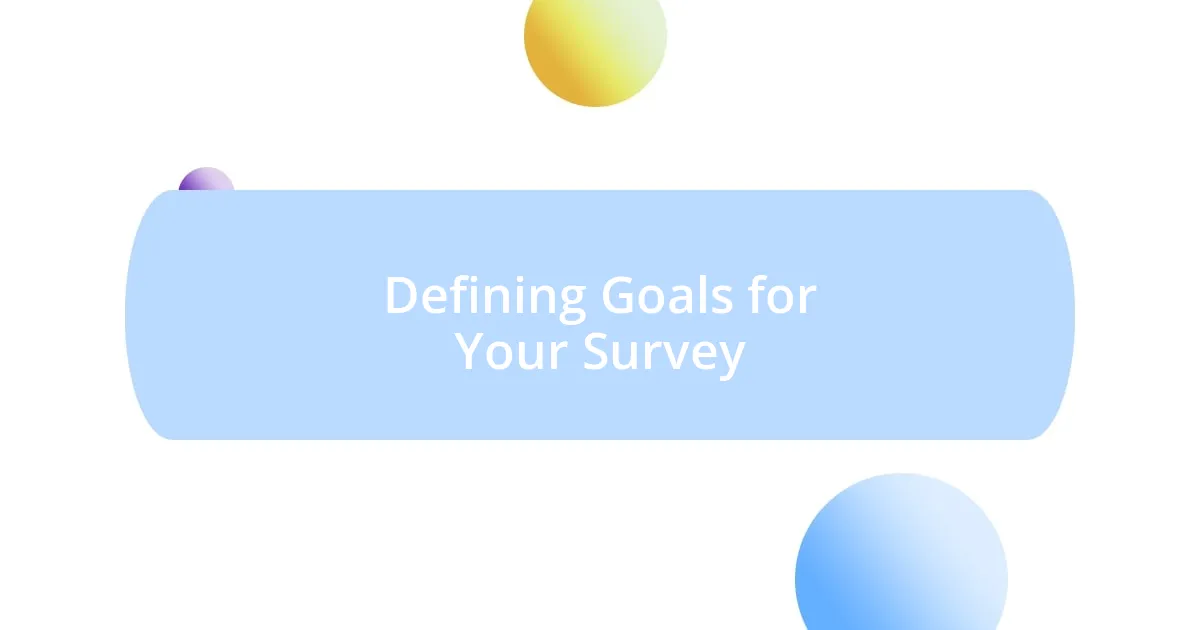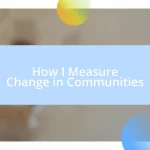Key takeaways:
- Surveys are valuable tools for understanding participant experiences and shaping initiatives based on emotional and factual feedback.
- Defining clear goals before conducting a survey ensures that questions are targeted and yield actionable insights.
- Choosing the appropriate survey method and timing significantly enhances the quality and relevance of the responses gathered.
- Analyzing survey results through segmentation and visualization helps uncover trends and informs effective decision-making.

Understanding Surveys for Impact
Surveys can be powerful tools for gauging the impact of initiatives. I remember conducting a survey after a community workshop, and the responses were eye-opening. They revealed not just what participants learned, but also how they felt about applying that knowledge in their daily lives. Have you ever wondered how feedback could shape the courses you offer or the products you create? That’s exactly the value surveys bring.
When I think about understanding surveys for impact, I can’t help but appreciate how they allow us to dive deep into people’s experiences and perceptions. One time, I implemented a survey for a nonprofit campaign. The insights we gathered helped us adjust our strategies and resonate more deeply with our audience. The joy of seeing that shift in our approach was incredibly fulfilling.
People often underestimate the emotional weight behind survey answers. Each response tells a story, reflecting individual experiences and collective sentiments. Isn’t it fascinating to think that a simple survey can open a dialogue about people’s needs and desires? In my practice, I’ve seen how these dialogues foster connection and drive meaningful change.

Defining Goals for Your Survey
Defining clear goals before launching a survey is essential. I often start by asking myself what specific information I want to gather and how it will inform my decisions. For instance, during one project, I aimed to understand participants’ challenges in accessing resources. By framing my goals around that focus, I was able to craft targeted questions, which resulted in actionable insights.
Sometimes, I find that less is more. Instead of trying to cover every aspect of a topic, narrowing my focus can yield deeper insights. I recall a time when I tried to include diverse themes in a single survey, but the feedback was scattered and less impactful. By honing in on one key goal, the data became clearer, and I could draw more significant conclusions. Have you experienced something similar when defining your survey’s purpose?
The goals you set not only guide your survey design but also influence the narrative your data tells. In my experience, establishing priorities helps me measure success accurately. For example, I once had a survey goal centered on improving user experience with a product. The results guided our iterative design process—transforming our offerings based on real user needs.
| Survey Goal | Description |
|---|---|
| Understand Challenges | Identify specific barriers faced by participants. |
| Measure Satisfaction | Gauge participant satisfaction with a service or product. |
| Inform Strategy | Use insights to adapt and refine approaches for better impact. |

Designing Effective Survey Questions
When it comes to designing effective survey questions, clarity is paramount. I often remind myself that the questions should be straightforward and avoid jargon. It’s easy to get caught up in technical terms, but I find that using plain language invites more genuine responses. For instance, during a recent survey focused on community health, I used simple language that participants related to, and the insights we gathered were profound and impactful.
Here are some key considerations I keep in mind when crafting questions:
– Be Specific: Aim for clarity in what you want to know. Instead of asking, “How do you feel about our service?” I might ask, “What was your experience with our customer support?”
– Limit Open-Ended Questions: While they can provide rich feedback, too many open-ended questions can overwhelm respondents. I space them out to encourage thoughtful responses without fatigue.
– Use a Mix of Question Types: Combining multiple choice, rating scales, and open-ended questions can help balance quantitative data with qualitative insights.
– Pilot Your Questions: Before sending out the survey, I often test my questions on a smaller group. This practice has saved me from potential confusion and has refined the questions based on real-time feedback.
– Avoid Leading Questions: It’s crucial not to sway responses. I make it a point to phrase questions neutrally to capture honest sentiments.
By keeping these strategies at the forefront of my survey design process, I feel much more confident that I’m collecting data that truly reflects the participants’ experiences. The right questions can unfold layers of information that turn vague sentiments into actionable insights.

Choosing the Right Survey Method
Choosing the right survey method is a crucial step in ensuring that I gather the most relevant data. I’ve found that the method I choose can significantly affect the quality of the responses. For example, when I switched from using only email surveys to incorporating in-person interviews for a community project, the depth of the responses improved dramatically. Isn’t it interesting how a simple change in approach can unlock richer insights?
I also consider my audience when selecting a method. I once targeted a tech-savvy group, opting for an online survey that leveraged social media, which resulted in a higher engagement rate. In contrast, I recall a different experience with an older demographic where a paper survey was far more effective. Tailoring my approach to the audience makes all the difference. Have you thought about how your audience’s preferences might influence your survey method?
Additionally, timing and context play vital roles in my decisions. While planning to survey for a new product, I realized that conducting it right after a major launch ensured participants had fresh experiences to share. This timing helped me gather potent insights that wouldn’t have been as vivid months down the line. How often do we consider the importance of context in our data collection efforts? Fine-tuning the method and timing can yield a wealth of valuable information.

Analyzing Survey Results
When I dive into analyzing survey results, I rely heavily on segmentation. Breaking down the data into categories—like age, location, or specific demographics—helps me understand the nuances of participant responses. For instance, during a survey on wellness programs, I noticed that younger respondents had vastly different feedback compared to older participants. This revelation spurred changes in our offerings, aligning them more closely with the varying needs of each group.
I also believe in the power of visualization when it comes to data interpretation. Graphs and charts not only make the results more digestible but also allow me to spot trends that might otherwise go unnoticed. I remember analyzing a community feedback survey where visualization of satisfaction ratings revealed a significant dip in one area that I hadn’t anticipated. Had I just relied on raw numbers, I might have missed that critical insight entirely. Why do we often overlook the storytelling aspect of data?
Finally, context matters immensely in analysis. I find it crucial to consider external factors that could have influenced responses. For instance, if I’m reviewing results from a survey conducted during a negative news cycle, those responses could be skewed. I once analyzed feedback from a product launch that coincided with a major industry scandal, and the data reflected a sense of skepticism that didn’t truly reflect user satisfaction. Don’t you agree that understanding the broader landscape can lead to more informed interpretations? Each of these factors shapes my understanding and the actionable outcomes I draw from survey results.

Implementing Changes Based on Feedback
When implementing changes based on feedback, I always prioritize transparency with my team and stakeholders. I vividly remember a time when our survey revealed a major gap in client satisfaction regarding our customer service. It felt a bit daunting to present this feedback, but I learned that openness fosters trust. Sharing the survey results not only encouraged collective problem-solving but also built a sense of ownership among the team. Have you ever experienced how sharing difficult information can actually strengthen collaboration?
I find that making small, incremental changes often yields the best results. After analyzing survey responses regarding our product features, we decided to tweak just one aspect of the interface that users found confusing. Surprisingly, that single adjustment led to a 15% uptick in overall satisfaction. It’s fascinating how even minor tweaks can lead to significant improvements. Isn’t it empowering to realize that we don’t always need to overhaul everything to see a difference?
Lastly, I embrace the idea of follow-up surveys after implementing changes. This practice not only allows me to measure the impact of adjustments but also shows participants that their feedback leads to real actions. I recall a follow-up survey where positive feedback poured in after we improved our onboarding process based on initial responses. It felt rewarding to see that connection between their voices and our actions. Do you think ongoing dialogue with contributors enhances their engagement and trust in the process? I know it does for me.

Measuring Long-Term Impact of Surveys
Measuring long-term impact from surveys is all about observing the trends over time. I remember conducting a survey on employee engagement that we repeated annually. The insights we gathered allowed me to see improvements—or declines—in morale and productivity, which informed our long-term strategies. Have you ever wondered how ongoing metrics can tell a story that a single snapshot simply can’t?
It’s also crucial to track specific outcomes related to the changes implemented following survey feedback. For instance, after introducing more flexible working hours based on initial survey insights, I noticed a tangible decrease in turnover rates over the next year. That correlation struck me deeply; it tied our adjustments directly to employee retention, reinforcing the importance of listening. Isn’t it powerful to see how our responses can shape a healthier workplace?
Lastly, I advocate for continuous reflection on the surveys’ impact, revisiting goals and outcomes regularly. Assessing whether we’re still aligned with the original purpose ensures that surveys don’t become a checkbox activity. The best experience I had was when we realized a previously implemented change had stagnated; we reignited our commitment to improvement and reignited our team’s enthusiasm. How often do we pause to assess our progress and celebrate the milestones achieved along the way?














